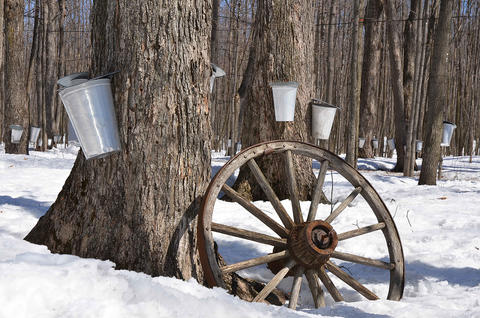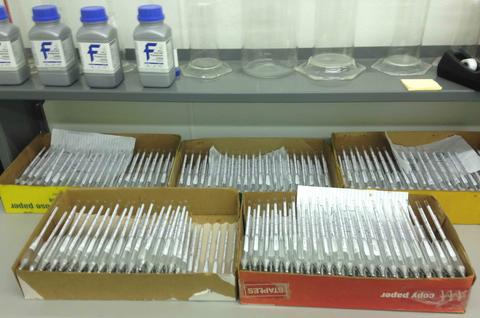
NIST is frequently asked to provide unusual, sometimes downright exotic, measurements and calibrations in support of U.S. commerce. But even old hands in the Fluid Metrology Group were surprised last fall when they were called into a dispute over the metrics of maple sap.
At issue was the accuracy of hydrometers—instruments which measure the density of liquids—used in Vermont’s legendary maple products industry to determine the sugar content of the sap extracted from trees every spring and then boiled down to make maple syrup.* All hydrometers used in the industry must be inspected and approved by the state. Between 2012 and 2016, the Vermont Agency of Agriculture, Food & Markets (AAF&M) tested 39,241 of them.
Sap sugar measurements are critically important to the business. It takes about 43 gallons of sap containing 2% sucrose to make a gallon of maple syrup, but only around 22 gallons for sap with 4% sugar content. So even a small discrepancy can have a significant impact on the value of the sap and on the recipes followed by makers of syrup and other maple products. Maple products are a major component of the Vermont’s economy. In 2013, the state’s maple industry “contributed between $317 and $330 million in sales to the state of Vermont,” according to a 2015 study. Vermont accounts for an estimated 42% of all U.S. maple products production.
Vermont tests hydrometers made in various states as well as foreign countries. NIST’s involvement began after a manufacturer sent a sap hydrometer to the AAF&M for calibration. The agency tested the instrument and judged that it was reading out of tolerance compared to Vermont’s reference standard. The manufacturer disagreed. Both parties, independently, turned to NIST.
“We served, in effect, as the arbiter,” says John Wright, Project Leader for flow measurements in NIST’s Physical Measurement Laboratory. The manufacturer sent its hydrometer to NIST; AAFM sent a reference standard hydrometer. Both were based on the Brix scale,** which has been utilized for two centuries to measure the sugar content of water solutions. It is used in the wine, soft drink, juice, and related industries. But not, as it turns out, by typical customers of the Fluid Metrology Group.
“I’ve been at NIST for 17 years,” says group member Sherry Sheckels, “and I’d never seen a Brix hydrometer.” Neither had Wright. Nor was there much help in the scientific literature. True, there were canonical tables—compiled by NIST’s predecessor, the National Bureau of Standards—dating from 1924 for the density of solutions of cane sugar at 20 °C (68 °F), but at no other temperature.
However, the maple industry uses 3.33 °C (38 °F) as its reference temperature. “The reference temperature for sap hydrometers is unique to hydrometry and to the maple industry,” says Marc Paquette of AAF&M. The agency had tried to find a laboratory that could calibrate its Brix sap hydrometer, but none could do it.
“One of the issues was the reference temperature,” Paquette says. “Most hydrometers are calibrated at a reference temperature of 60 °F or 68 °F (20 °C). But maple sap is collected in the early spring when temperatures are low, often slightly above freezing. We couldn’t find a lab that was able to adjust for the change in the reference temperature.”
Temperature is a key factor because thermal expansion or contraction affects both the density of the fluid and the dimensions of the hydrometer. Those effects have to be accounted for, as do the forces exerted on the hydrometer stem by the surface tension of the fluid*** and the fact that the hydrometer has a small but significant buoyancy in air.
NIST uses Cuckow's Method to calibrate hydrometers, measuring the weight of the customer’s hydrometer, once in air and again when it is suspended at the stem scale mark of interest in a liquid of well-known density. However, it is necessary to relate the density measured in the NIST’s apparatus near 20 °C to the density on the Brix scale at the reference temperature of 3.33 °C.

To make the NIST-Brix connection, Wright and Sheckels prepared sugar solutions of 3% and 6% sucrose (with uncertainty less than 0.001% by weight) and measured their density down to 3.33 °C. Their data confirmed published density tables to within 50 parts per million. To further validate the NIST calibration results, the customers’ hydrometers were also tested (with the NIST corrections) in the refrigerated 3% and 6% sucrose solutions. These tests confirmed the Cuckow’s apparatus calibration.
“We calibrated these two hydrometers and showed that the reference Vermont was using was correct,” Wright says. “And we explained to the manufacturer how to correctly account for the 3.33 °C reference temperature. After sorting out what a correct calibration required, we educated our customers.”
Neither Paquette nor hydrometer manufacturers were familiar with NIST’s test methods. But “they did an exhaustive test of the instrument including an impressive uncertainty budget,” Paquette says. “It also gave us the opportunity to review our testing process and incorporate the standard into that process.”
The effects will be felt beyond the state of Vermont and one manufacturer: Paquette’s lab has tolerance-tested hydrometers for maple equipment suppliers in New Hampshire, Pennsylvania, New York, Wisconsin, Indiana, Connecticut, and Michigan. Thus a single NIST hydrometer calibration is leveraged by nearly 10,000 maple sap hydrometer tests per year performed by state labs, ensuring equitable trade and quality products for a $700 million per year industry.
* Maple sap typically contains anywhere from 1% to 5% sugar by mass. Finished maple syrup is about 66% sugar, and requires a different hydrometer to measure its density.
** The Brix scale is one of the two most widely used scales for measuring sugar content by mass. 1 degree Brix is equivalent to 1 gram of sucrose dissolved in 100 grams of water.
*** Owing to surface tension, water (like most other liquids) clings to the hydrometer’s glass stem slightly above the surface of the surrounding liquid in a curved formation called a meniscus. This exerts a downward force on the hydrometer, which must be accounted for in measurements.

